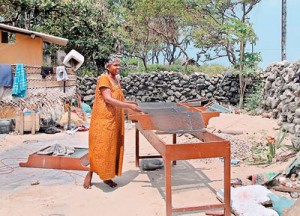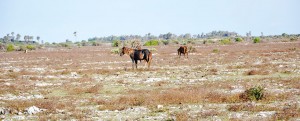Jaffna:Building back better with value-added research
The three-decade long civil conflict in Jaffna severely impinged on the daily lives of the communities who lived on the peninsula. Although education — at all levels — continued despite the adversities, biological field research suffered and stalled for 30 years.

Hygienic, low-salt dried fish production on Delft Island using elevated benches. (Pic by Kumudini Ekaratne © IUCN)
Post 2009, the picture is very different. With freedom to move around, universities in Jaffna are now out in the field, collecting data for various research studies. And here, as in the rest of the island, ecosystems provide a rich source of information.
The Jaffna peninsula — connected to the rest of the land mass by a small strip of land — is unique ecologically as it lacks any natural streams or rivers, of which there are 103 coursing through the rest of the island. It also houses the largest brackish water system in the island, the Jaffna Lagoon Complex: Jaffna, Uppu Aru and Chundikulam, collectively extending over 441 square kilometres, as well as the Thondaimanaaru Lagoon, which is 74.5 square kilometres. Fringing these lagoons are mangroves,large tidal flats and salt marshes. Edging the peninsula are extensive sand dunes; surrounding it are coral reefs and seagrass meadows.
Off the coastline of this peninsula, are several islands — Analaitivu, Chirutivu, Delft, Eluvaitivu, Karativu, Karaitivu,Kayts, Mandativu, Nagadeepa or Nainativu, and Punkudutivu — less populated than the peninsula.With funding from the Small Grant Facility (SGF) of Mangroves for the Future (MFF) regional initiative, scientists from the Department of Chemistry at the University of Jaffna set out to develop a socio-ecological profile of the Jaffna Lagoon, in order to support the upcoming development efforts while ensuring the sustainability and resilience of ecosystems.
Jaffna Lagoon is a large lagoon, about 400 km, opening in the southwest into the Palk Bay and in the northwest, between Kayts and the most western tip of the peninsula. The study assessed the composition of the flora and fauna of the Lagoon; analysed lagoon water and mud; and collected socio-economic data of communities living around the lagoon.
Mangroves, salt marshes, mud flats and sea grass meadows were observed in the Lagoon area.Five species of mangrove plants, and two species of plants from salt marshes were observed. One hundred species of fin fish, 28 species of molluscs, six species of crabs and seven species of prawns were identified in the catches from the Lagoon, indicating a richness of species important for fisheries.
Data collected from a 1,000 households living around the Lagoon revealed that a quarter of people living around the Lagoon were full-time fishermen, nearly all of whom use traditional methods of fishing, 85.4% of whom fish in the Lagoon, showing how important the Lagoon is for fisheries and their lives. Nearly a tenth of the population was below the poverty line, indicating the need to improve livelihoods, and at the same time ensure that the health of the Lagoon is not damaged.
The study revealed that the water quality in certain areas of the Lagoon raised some serious concerns, as there was exceptional salinity in the Thenmaradchi area. Such hyper-salinity changes the composition of species in the Lagoon — for example, salt-tolerant species will survive while others will not. These changes will have profound impacts on fisheries.
In addition, in the areas of Navanthurai, Pannai, Gurunagar, Columbuthurai and Paasayoor, the researchers found increased phosphate levels and a high occurrence of Escherichia coli indicating pollution from agrochemicals and dumping of sewage. These changes will not only affect fisheries but also the health of lagoon communities.

Delft, famous for its wild ponies
In Kilaly, land mines have not yet been cleared fully, although fishermen do fish there. Fishermen in Araliththurai and Ponnalai were found to be using small-sized mesh nets, which is an unsustainable practice as it catches juveniles, as well as target species.
Post conflict development has already had a negative impact on the Lagoon, for example, the reconstruction of the Jaffna-Pannai road has blocked the free flow of water, resulting in a reduction of fish catch in the fish landing site of Navanthurai, which is beyond this blockage.Another road constructed for the Mandaitivu village partitioned a wetland, resulting in a differentiation in salinity between the two portions of the wetland, again with consequences for species within this wetland. Yet another road has been built on the island of Chirutivu, destroying the lush mangrove vegetation there.
The Hector Kobbekaduwa Agrarian Research and Training Institute (HARTI), also supported by the MFF’s Small Grant Facility, took a different approach and examined the value, in monetary terms, of the Jaffna Lagoon. They found the total value of fish production provided by the Lagoon each year to be 6,100 million rupees. They calculated the total economic value of Jaffna Lagoon to be 7,608 million rupees per year, and qualify their findings by saying this figure is an under estimation, as ecosystem services — such as carbon sequestration, flood protection — were not valued.
To the east of Jaffna Lagoon, lies the elongated and narrow Thondaimanaaru lagoon, opening in the north into the Palk Strait. The surrounds are heavily populated by communities being resettled after the conflict. In the 1950s, a barrage was built near the mouth of this Lagoon (less than two kilometres from the sea)restricting the natural ebb and flow of sea water into the lagoon. Here, the Department of Zoology of the University of Jaffna, under the aegis of MFF, carried out a baseline analysis for development opportunities in the area. They found that the ecosystems in the area are mangroves, salt marshes, mud flats and sea grass meadows, providing homes to 13 species of migratory birds, including four species of sand piper, two species of plover and two species of ducks.Here, the majority of species observed in fish catches were molluscs (38 species), with four species of fin fish, two species of crabs and five species of prawns also found. Several species of mangrove and salt marsh plants were also observed. Again, this list of species indicates not only how important the Lagoon is for fisheries, but also for migratory birds.
Analysis of socio-economic data by the same researchers showed that there were 327 fisher families around the Thondaimanaaru lagoon, indicating a high pressure from lagoon-based fishing.
To the east of the Thond-aimanaaru Lagoon lie some magnificent sand dunes and one of the most beautiful beaches in Sri Lanka — Manalkadu. Here, as was the practice in the 1970s, the Forest Department began planting an eight kilometre belt of Casuarina to prevent erosion and protect communities from the force of extreme weather events. Neglected as a consequence of the civil conflict, severely damaged by the Indian Ocean Tsunami of December 2004, currently subjected to destruction, this belt became the focus of a community-based organisation, Aaruthal Sri Lanka. Through a grant from the SGF, 375 families in the area were mobilised and empowered through education and awareness programmes to use sustainably this anthropogenic patch of forest.
On the west, is an island popularly known as Delft (named by the Dutch), known by the Portuguese as Ilha das Vacas, and by the locals, Neduntivu. Delft, famous for its wild ponies, baobab tree, coral fences, and historical ruins, is home to a population of about 4,500. Of this, about 1,200 fishermen in 560 families are engaged in fishing as their main livelihood. A fisherman’s entire catch has to be sold on the same day of the catch as there are no facilities for freezing fish on the island.As a way around this constraint, 80 families are engaged in drying fish and marketing the dried fish. The Sevalanka Foundation, supported by MFF’s Small Grant Facility, began a project with 40 fisherwomen, to introduce a process to make dry fish with more hygienic conditions using less salt. The Foundation reports a 31% increase in the monthly income of the beneficiaries and a ‘niche market’ for the low-salt dried fish, that targets the health-conscious segment of population who prefer low-salt meals. The socio-ecological studies carried out by the University of Jaffna accrued baseline data regarding the flora and fauna and communities, all of which will be invaluable for future monitoring. These projects also created awareness among the general public, fisher communities and government officials. The Sevalanka project mobilised the communities and improved their livelihoods. The HARTI project quantified the value of the Jaffna Lagoon.
The Thondaimanaaru Lagoon study disseminated their results to the stakeholders, including local government officials, through a number of workshops and training programmes and proposed a strategic plan for the future development of the Lagoon, that included recommendations for soft engineering solutions to replace the barrage that has restricted water flow in and out of the Lagoon; declaration of the area as a bird sanctuary; and promotion of ecotourism.
The findings of all research carried out under the aegis of MFF’s SGF programme have also been shared in Colombo among key line agencies, such as the Department of Wildlife Conservation and the Marine Environmental Protection Agency.
The achievements of these projects are many, but so, unfortunately, are the general problems in the peninsula. As with the rest of the island, the ecosystems of Jaffna too are falling to the axe of unplanned development, as seen in Chirutivu island. Pollutants from cultivation and homes are washing into the lagoons of Jaffna, just as they are choking other lagoons in the country, such as the Lunawa Lagoon. Ill-conceived hydrological alterations of lagoon outlets such as in Thondaimanaaru Lagoon — are changing salinities, with dire consequences for fisheries, as was the case of the hypersaline Mundel Lake. Fishermen fish unsustainably — either using small-meshed nets or simply taking too much. (See the article titled ‘Fishing for sea cucumbers– how long can this go on?’ November 16, 2014.) Again, this mirrors practices in many lagoons in the rest of the island, far too many to mention here. Climate change — with increasing extreme weather events, rising sea levels and changes in weather patterns — added to this mix, will also have serious consequences.
These problems are simply not a rhetoric of conservation, but they will, ultimately, impact the people of Jaffna, who have already had more than their share of tribulations. The destruction of mangroves, salt marshes, tidal flats and sand dunes is equivalent to forfeiting natural flood regulators and natural protection from extreme weather events. Altering the natural flow of lagoons results in a loss for fisheries. Destruction of seagrass meadows and mangroves is the same as razing the nurseries of fish and shell fish species important to us. Damaging seagrasses removes a natural means of filtering sediments and pollutants from water.
There was an opportunity in Jaffna to learn from the mistakes we had made in various infrastructure development projects in the rest of the island. Unfortunately, we have not done so.
| All about MFF Mangroves For the Future (MFF) is a unique partner-led initiative to promote investments in coastal ecosystem conservation for sustainable development. Co-chaired by IUCN and UNDP, MFF provides a platform for collaborations among different agencies, sectors and countries, which are addressing challenges related to coastal ecosystems or livelihood issues. The goal of MFF, which is operational in 11 countries, is to promote an integrated ocean-wide approach to coastal management and to enhance the resilience of ecosystem-dependent coastal communities.MFF Programme in Sri Lanka is managed by IUCN and funded by SIDA, NORAD and Danida. MFF’s Small Grant Facility is a mechanism by which funding is provided for small-scale projects. Since its inception in Sri Lanka in 2009, the MFF Small Grant Facility has awarded 85 grants with a total value of rupees 65,187,950 to support a range of projects for coastal conservation and livelihood improvement. | |


